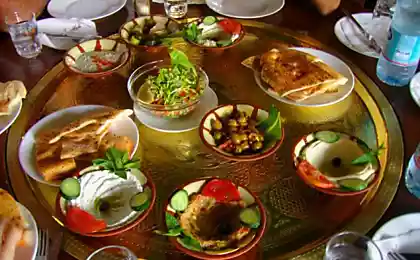3798
Exotic dishes
Which just crazy and extreme variety of dishes and delicacies not eat the representatives of different nations in the world. Today we want to tell you about some of them. We promise you will not soon forget about this.
Warning! The contents of this article are not recommended for those particularly impressionable and those who have recently had breakfast.

Century egg - this ingredient used in Chinese cuisine, which is added to salads and other sophisticated dishes. During its preparation yolk duck, chicken or quail eggs becomes dark green or gray, acquires a creamy consistency, the smell of ammonia and sulfur. At the same time, the protein typically is colored dark brown color and becomes semitransparent jelly like.

These changes occur due to the deliberate increase in pH eggs and sodium content in it. Thus, according to the traditional method of cooking by first making a mixture of an alkali clay, wood ashes, burnt lime and sea salt. Using rubber gloves that cover each egg mass, and then collapses in rice husk. Subsequently, these eggs are placed in sealed cans or cloth tightly woven baskets, where they will be stored for many months, until the mixture is completely cured. When this happens, the century-old eggs will be cleared of the masses, and they will be ready for use.
It is believed that the method of preparation of century eggs originated from the need to store eggs. According to some reports, an unusual recipe appeared about 600 years ago in Hunan Province in the Ming Dynasty (1368 - 1662 years).
Interestingly, some century-old eggs after cooking a yellowish pattern on the protein, which is similar to tree branches.

Edible bird's nest - it's one of the most expensive animal products, which are now an average cost of $ 2,500 per kilogram in Asia. Nests, which can have a build primarily swifts Aerodramus fuciphagus and Aerodramus maximus.

These birds make their nests out of salivary fluid in the form of a small cup that attaches to the wall of the cave. Saliva serving the building material, rich in calcium, iron, potassium and magnesium. And therefore, is believed to be edible sockets (particularly red and white) to improve digestion, increase libido, concentration and generally beneficial effect on the immune system.
Today, Hong Kong and the United States are the largest importers of these nests. For example, in Hong Kong, a bowl of soup with bird's nest is $ 30-100, a kilogram of white nests can cost $ 2,000, while a kilo of red - $ 10 000. The latest, most expensive nests were collected only in limestone caves on the islands in Thailand.
Edible nests used in Chinese cooking for over 400 years, most often as an ingredient in soup. However, as they are prepared with rice, add in egg cake and other desserts.

"Black Ivory". So called grade of coffee, which is produced exclusively in northern Thailand by Black Ivory Coffee Company Ltd. The peculiarity of this coffee is that it is "ready" in the stomach of an elephant. So, elephants consume berries Arabian coffee, which, falling into the stomach of animals, are influenced by gastric acid. It breaks down proteins coffee and gives it a specific taste. Through 15-70 hours of coffee goes along with the feces of an elephant, after which it was collected, to clean and prepare to sell.
In the preparation of this coffee is involved about 20 elephants from the fund Golden Triangle Asian Elephant Foundation. Ready coffee is sent to the company Black Ivory Coffee Company Ltd, which is 8% of the profits from its sales pays into the fund.
Moreover, it is important to note that this kind of coffee - one of the most expensive in the world today. Its price is on average $ 1,100 per kilogram. The high price of coffee is made up of a number of factors, including the presence of appetite elephants and lots of coffee berries, necessary for the production of "black ivory". For example, 33 kilograms of coffee berries is obtained only 1 kilogram of "black ivory" because the majority of berries is fragmented during chewing elephant, and also because the berries are released from the faeces, it is extremely difficult to find in the grass. According to Veterinary Research, coffee berries are not adversely affected by elephants simply because caffeine is not absorbed in their stomach.

Casu marzu. This traditional Sardinian sheep's milk cheese from the singularities that contains live insect larvae. The creators of this cheese, Giovanni Gabbas and Andrew Zimmern call it taste "very ammoniated" since entering the mouth, tongue cheese burns. It also leaves a specific finish, which lasts for several hours.
Preparation Casu marzu begin with the fact that part of the peel is removed with sheep cheese to cheese fly could be postponed for him eggs and hatched larvae - easily gnaw their way into the cheese. Acid from the digestive system breaks down fats larvae, and the cheese becomes very soft. By the time the cheese is ready for use, it will already contain thousands of larvae. Also from the finished Casu marzu starts leaking fluid - lagrima, which translated from Latin means "tears."
Usually larvae settled in the cheese are white, translucent worms about 8 mm in length. If disturbed (for example, cut a piece of cheese), they can jump a distance of 15 centimeters. Some people eat Casu marzu with these larvae, and others - clean them before use.
Casu marzu eat, usually moistened with Sardinian flat bread (pane carasau) and strong red wine.

Interestingly, the addition Casu marzu in Europe, there are other types of cheese with maggots. For example, cheese made from goat's milk cheese fly larvae, aged in white wine with grapes and honey. There are also German and French cheese Milbenkäse cheese Mimolette, which are prepared with the help of live cheese mites.

Virgin boy egg - a traditional delicacy from the Chinese province of Zhejiang, which is an egg cooked in the urine of boys.
Each year, manufacturers Virgin boy egg collect urine boys who have not reached puberty (around 10 years), from toilets schools. Then soaked and boiled eggs in it. When the shell cracks, boiled eggs already at a low heat. Preparation Virgin boy egg normally takes all day. By the way, such eggs are twice normal eggs.
Residents of Zhejiang Province believe that Virgin boy egg lowers body temperature and improves blood circulation in the body. However, some doctors believe that the urine does not have any useful properties, since it is just a waste of the human body.
It is interesting that in 2008 the Virgin boy egg was recognized intangible cultural heritage of Zhejiang Province.

"Smelly head» (Stinkheads). Before there were modern methods of food preservation in fresh form, there fermentation (fermentation). For example, many people with the help of this method prevents the ability of microbes to spoil the fish. This occurred due to the increase in fish tissues acid, because of which the bacteria multiply stopped, and as a result, it was possible to keep the food in the form suitable for use.
Nowadays, there are many other methods of preserving fish, but some people continue to ferment it. For example, Siberian Yupik people, the indigenous peoples of western and south-western regions of Alaska and the Russian Far East, fermented head whitefish, fish from the salmon family. To do this, they put the fish heads, guts and sometimes in a wooden barrel, closed her sacking and buried in the ground for about a week.
Ready whitefish heads have specific putrid odor, for which he received the name - "smelly head."

Source: www.nat-geo.ru
Warning! The contents of this article are not recommended for those particularly impressionable and those who have recently had breakfast.

Century egg - this ingredient used in Chinese cuisine, which is added to salads and other sophisticated dishes. During its preparation yolk duck, chicken or quail eggs becomes dark green or gray, acquires a creamy consistency, the smell of ammonia and sulfur. At the same time, the protein typically is colored dark brown color and becomes semitransparent jelly like.

These changes occur due to the deliberate increase in pH eggs and sodium content in it. Thus, according to the traditional method of cooking by first making a mixture of an alkali clay, wood ashes, burnt lime and sea salt. Using rubber gloves that cover each egg mass, and then collapses in rice husk. Subsequently, these eggs are placed in sealed cans or cloth tightly woven baskets, where they will be stored for many months, until the mixture is completely cured. When this happens, the century-old eggs will be cleared of the masses, and they will be ready for use.
It is believed that the method of preparation of century eggs originated from the need to store eggs. According to some reports, an unusual recipe appeared about 600 years ago in Hunan Province in the Ming Dynasty (1368 - 1662 years).
Interestingly, some century-old eggs after cooking a yellowish pattern on the protein, which is similar to tree branches.

Edible bird's nest - it's one of the most expensive animal products, which are now an average cost of $ 2,500 per kilogram in Asia. Nests, which can have a build primarily swifts Aerodramus fuciphagus and Aerodramus maximus.

These birds make their nests out of salivary fluid in the form of a small cup that attaches to the wall of the cave. Saliva serving the building material, rich in calcium, iron, potassium and magnesium. And therefore, is believed to be edible sockets (particularly red and white) to improve digestion, increase libido, concentration and generally beneficial effect on the immune system.
Today, Hong Kong and the United States are the largest importers of these nests. For example, in Hong Kong, a bowl of soup with bird's nest is $ 30-100, a kilogram of white nests can cost $ 2,000, while a kilo of red - $ 10 000. The latest, most expensive nests were collected only in limestone caves on the islands in Thailand.
Edible nests used in Chinese cooking for over 400 years, most often as an ingredient in soup. However, as they are prepared with rice, add in egg cake and other desserts.

"Black Ivory". So called grade of coffee, which is produced exclusively in northern Thailand by Black Ivory Coffee Company Ltd. The peculiarity of this coffee is that it is "ready" in the stomach of an elephant. So, elephants consume berries Arabian coffee, which, falling into the stomach of animals, are influenced by gastric acid. It breaks down proteins coffee and gives it a specific taste. Through 15-70 hours of coffee goes along with the feces of an elephant, after which it was collected, to clean and prepare to sell.
In the preparation of this coffee is involved about 20 elephants from the fund Golden Triangle Asian Elephant Foundation. Ready coffee is sent to the company Black Ivory Coffee Company Ltd, which is 8% of the profits from its sales pays into the fund.
Moreover, it is important to note that this kind of coffee - one of the most expensive in the world today. Its price is on average $ 1,100 per kilogram. The high price of coffee is made up of a number of factors, including the presence of appetite elephants and lots of coffee berries, necessary for the production of "black ivory". For example, 33 kilograms of coffee berries is obtained only 1 kilogram of "black ivory" because the majority of berries is fragmented during chewing elephant, and also because the berries are released from the faeces, it is extremely difficult to find in the grass. According to Veterinary Research, coffee berries are not adversely affected by elephants simply because caffeine is not absorbed in their stomach.

Casu marzu. This traditional Sardinian sheep's milk cheese from the singularities that contains live insect larvae. The creators of this cheese, Giovanni Gabbas and Andrew Zimmern call it taste "very ammoniated" since entering the mouth, tongue cheese burns. It also leaves a specific finish, which lasts for several hours.
Preparation Casu marzu begin with the fact that part of the peel is removed with sheep cheese to cheese fly could be postponed for him eggs and hatched larvae - easily gnaw their way into the cheese. Acid from the digestive system breaks down fats larvae, and the cheese becomes very soft. By the time the cheese is ready for use, it will already contain thousands of larvae. Also from the finished Casu marzu starts leaking fluid - lagrima, which translated from Latin means "tears."
Usually larvae settled in the cheese are white, translucent worms about 8 mm in length. If disturbed (for example, cut a piece of cheese), they can jump a distance of 15 centimeters. Some people eat Casu marzu with these larvae, and others - clean them before use.
Casu marzu eat, usually moistened with Sardinian flat bread (pane carasau) and strong red wine.

Interestingly, the addition Casu marzu in Europe, there are other types of cheese with maggots. For example, cheese made from goat's milk cheese fly larvae, aged in white wine with grapes and honey. There are also German and French cheese Milbenkäse cheese Mimolette, which are prepared with the help of live cheese mites.

Virgin boy egg - a traditional delicacy from the Chinese province of Zhejiang, which is an egg cooked in the urine of boys.
Each year, manufacturers Virgin boy egg collect urine boys who have not reached puberty (around 10 years), from toilets schools. Then soaked and boiled eggs in it. When the shell cracks, boiled eggs already at a low heat. Preparation Virgin boy egg normally takes all day. By the way, such eggs are twice normal eggs.
Residents of Zhejiang Province believe that Virgin boy egg lowers body temperature and improves blood circulation in the body. However, some doctors believe that the urine does not have any useful properties, since it is just a waste of the human body.
It is interesting that in 2008 the Virgin boy egg was recognized intangible cultural heritage of Zhejiang Province.

"Smelly head» (Stinkheads). Before there were modern methods of food preservation in fresh form, there fermentation (fermentation). For example, many people with the help of this method prevents the ability of microbes to spoil the fish. This occurred due to the increase in fish tissues acid, because of which the bacteria multiply stopped, and as a result, it was possible to keep the food in the form suitable for use.
Nowadays, there are many other methods of preserving fish, but some people continue to ferment it. For example, Siberian Yupik people, the indigenous peoples of western and south-western regions of Alaska and the Russian Far East, fermented head whitefish, fish from the salmon family. To do this, they put the fish heads, guts and sometimes in a wooden barrel, closed her sacking and buried in the ground for about a week.
Ready whitefish heads have specific putrid odor, for which he received the name - "smelly head."

Source: www.nat-geo.ru
























